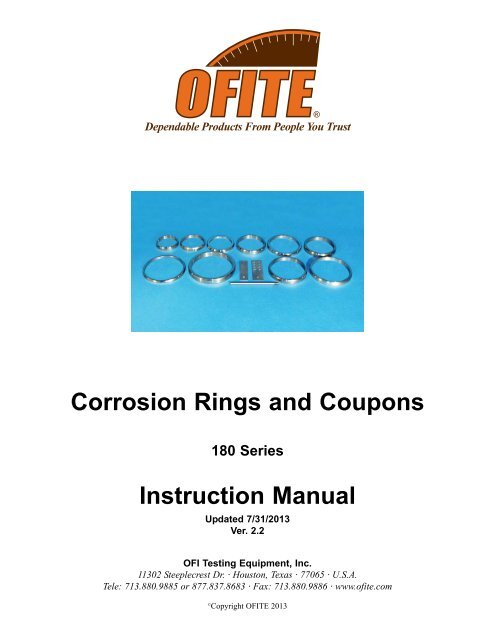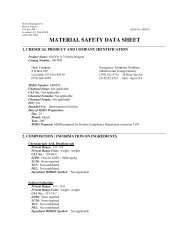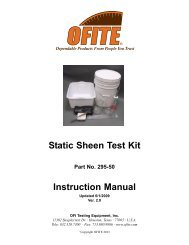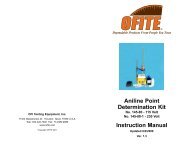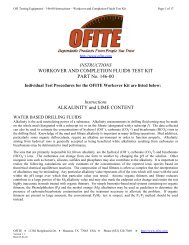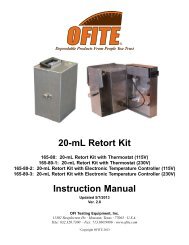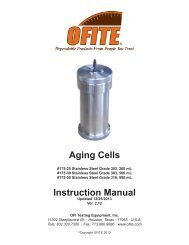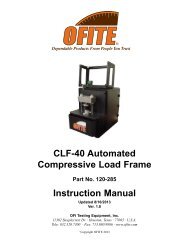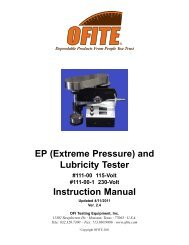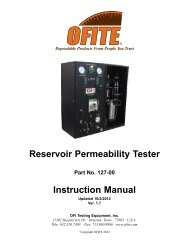Corrosion Rings and Coupons - OFI Testing Equipment, Inc.
Corrosion Rings and Coupons - OFI Testing Equipment, Inc.
Corrosion Rings and Coupons - OFI Testing Equipment, Inc.
You also want an ePaper? Increase the reach of your titles
YUMPU automatically turns print PDFs into web optimized ePapers that Google loves.
<strong>Corrosion</strong> <strong>Rings</strong> <strong>and</strong> <strong>Coupons</strong><br />
180 Series<br />
Instruction Manual<br />
Updated 7/31/2013<br />
Ver. 2.2<br />
<strong>OFI</strong> <strong>Testing</strong> <strong>Equipment</strong>, <strong>Inc</strong>.<br />
11302 Steeplecrest Dr. · Houston, Texas · 77065 · U.S.A.<br />
Tele: 713.880.9885 or 877.837.8683 · Fax: 713.880.9886 · www.ofite.com<br />
©<br />
Copyright <strong>OFI</strong>TE 2013
Table of<br />
Contents<br />
Introduction ......................................................................................3<br />
Components......................................................................................4<br />
Procedure..........................................................................................5<br />
Calculations ......................................................................................6<br />
<strong>OFI</strong>TE, 11302 Steeplecrest Dr., Houston, Texas 77065 USA / Tel: 713-880-9885 / Fax: 713-880-9886 / www.ofite.com 2
Introduction<br />
The placement of corrosion test rings in the drill string is routinely used to<br />
evaluate the corrosiveness of the drilling fluid environment on the drill string<br />
<strong>and</strong> other steel parts. Removal <strong>and</strong> examination of these rings after a period<br />
of exposure can be highly informative as to the corrosiveness of the<br />
drilling fluid <strong>and</strong> the type of corrosion encountered. A close examination of<br />
the scales <strong>and</strong> pits on the exposed rings will aid in choosing the proper<br />
remedial action.<br />
In a laboratory setting, corrosion coupons are more common. These are<br />
placed into special corrosion test cells <strong>and</strong> pressurized <strong>and</strong>/or heated while<br />
aging. Instructions for installing corrosion coupons will be included with the<br />
corrosion cell. The procedure for calculating corrosion rate is the same for<br />
rings <strong>and</strong> coupons.<br />
<strong>Corrosion</strong> rings are made from AISI 4130 cold drawn seamless mechanical<br />
tubing similar to drill pipe. <strong>Coupons</strong> are made from cold rolled steel.<br />
<strong>OFI</strong>TE, 11302 Steeplecrest Dr., Houston, Texas 77065 USA / Tel: 713-880-9885 / Fax: 713-880-9886 / www.ofite.com 3
Components<br />
<strong>Corrosion</strong> <strong>Coupons</strong>:<br />
#180-08 Rod Coupon; 4½" × ¼" Diameter<br />
#180-10 Scale Coupon; 1" × 3" × 1/16" (with Holes)<br />
#180-12 <strong>Corrosion</strong> Coupon; 1" × 3" × 1/16"<br />
#180-34 <strong>Corrosion</strong> Coupon; ¾" × 3" × 1/16"<br />
Holders:<br />
#180-00 Coupon Holder for Flat Coupon; 1" NPT<br />
#180-02 Coupon Holder for Flat Coupon; 2" NPT<br />
#180-04 Nylon Grommet; Package of 10<br />
#180-06 Coupon Holder for Rod Coupon; 2" NPT<br />
Part #<br />
Drill Pipe Size <strong>and</strong><br />
Type<br />
K-Factor Ring Dimensions<br />
#180-14<br />
2.875" Internal Flush<br />
<strong>and</strong> 3.500" Slim Hole<br />
394 2.425" OD; 2.125" ID<br />
#180-16<br />
3.500" Extra Hole <strong>and</strong><br />
3.500" Full Hole<br />
357 2.685" OD; 2.405" ID<br />
#180-18<br />
3.500" Internal Flush<br />
<strong>and</strong> 3.500" Full Hole<br />
337 2.965 OD"; 2.435" ID<br />
#180-20 4.000" Full Hole 256 3.156" OD; 2.82" ID<br />
#180-22<br />
4.000" Internal Flush<br />
<strong>and</strong> 4.500" Extra Hole<br />
250 3.703" OD; 3.227" ID<br />
#180-24<br />
4.500" Full Hole <strong>and</strong><br />
4.500" Extra Hole <strong>and</strong> 207 3.500" OD; 3.00" ID<br />
4.000" Internal Flush<br />
#180-26<br />
4.500" Internal Flush<br />
<strong>and</strong> 5" Extra Hole<br />
253 4.185" OD; 3.749" ID<br />
#180-28<br />
5.563", 5.500" API<br />
Regular or Full Hole <strong>and</strong> 134 4.590" OD; 4.004" ID<br />
6.625" API Regular<br />
#180-30 4.500" Extra Hole 184 3.805" OD; 3.399" ID<br />
#180-32 5" Extra Hole Tool Joint 179.12 4.185" OD; 3.745" ID<br />
<strong>OFI</strong>TE, 11302 Steeplecrest Dr., Houston, Texas 77065 USA / Tel: 713-880-9885 / Fax: 713-880-9886 / www.ofite.com 4
Procedure<br />
1. Place the corrosion ring into the tool joint in the drill string. Allow the<br />
ring to be exposed to the drilling fluid for at least 40 hours. A typical<br />
test time is 100 hours.<br />
!<br />
Important<br />
For corrosion coupons, refer to the instruction manual provided with the<br />
aging cell being used.<br />
Always wear clean, dry gloves when h<strong>and</strong>ling corrosion rings or<br />
coupons. Do not remove them from the protective packing until<br />
you are ready to begin the test.<br />
2. Carefully remove the ring from the tool joint. Immediately wipe the ring<br />
with a clean cloth to remove any drilling fluid residue.<br />
3. Carefully examine the ring. Note any severe corrosion or mechanical<br />
damage on the mailing envelope.<br />
Note<br />
!<br />
Important<br />
Severe mechanical damage will invalidate the test. Cuts or dents on<br />
the outer surface indicates considerable movement within the toolbox<br />
recess <strong>and</strong> should be noted in the report.<br />
If severe corrosion is evident, the cause of the corrosion should<br />
be determined promptly <strong>and</strong> remedial action taken immediately.<br />
4. Thoroughly dry the ring <strong>and</strong> place it in the corrosion-inhibiting wrapper<br />
<strong>and</strong> then in the original shipping envelope. Each envelope <strong>and</strong> ring are<br />
marked by a corresponding serial number.<br />
5. The ring should be thoroughly cleaned <strong>and</strong> weighed to the nearest milligram<br />
as soon as possible to avoid further corrosion.<br />
If the ring is not reweighed on-site, ship the envelope via overnight or second<br />
day air to <strong>OFI</strong>TE. Be sure all the requested information on the envelope<br />
is filled in along with a contact name <strong>and</strong> phone number <strong>and</strong> ship it to:<br />
<strong>OFI</strong> <strong>Testing</strong> <strong>Equipment</strong><br />
11302 Steeplecrest Dr.<br />
Houston, Texas 77065 (USA)<br />
Attn: <strong>Corrosion</strong> <strong>Testing</strong><br />
<strong>OFI</strong>TE will clean <strong>and</strong> weigh the ring to determine the weight loss. The corrosion<br />
weight is then calculated in pounds per square foot per year, kilograms<br />
per square meter per year, or in mils per year (metal loss in thous<strong>and</strong>ths<br />
of an inch per year). A nominal fee is charged for this service.<br />
Note<br />
It should be noted that the loss of metal is due to both corrosive <strong>and</strong><br />
erosive effects of the drilling fluid, since the bore of the ring is exposed<br />
to the fluid pumped down the drill string. Loss from erosion may be<br />
substantial when the drilling fluid contains a high concentration of s<strong>and</strong><br />
or abrasive material.<br />
<strong>OFI</strong>TE, 11302 Steeplecrest Dr., Houston, Texas 77065 USA / Tel: 713-880-9885 / Fax: 713-880-9886 / www.ofite.com 5
Calculations<br />
The difference between the initial <strong>and</strong> final weight of the corrosion ring or<br />
coupon is attributed to corrosion. The corrosion rate is calculated <strong>and</strong><br />
reported as lb/ft 2 /year or mils per year (mpy). The term “mils per year”<br />
refers to the loss of metal in thous<strong>and</strong>ths of an inch per year.<br />
<strong>Corrosion</strong> rings <strong>and</strong> coupons are supplied with a corresponding K factor.<br />
The K factor is a constant that takes into account the exposed surface area<br />
<strong>and</strong> density of the ring. It is provided to make calculations easier.<br />
Weight Loss (g)<br />
<strong>Corrosion</strong> Rate (lb/ft 2 /year) =<br />
Exposure Time (hours)<br />
× K<br />
<strong>Corrosion</strong> Rate (mpy) = lb/ft 2 /year × 24.62<br />
A corrosion rate of 2 lb/ft 2 /year or 50 mpy or less is usually considered<br />
acceptable. However, this may vary with individual conditions.<br />
<strong>OFI</strong>TE, 11302 Steeplecrest Dr., Houston, Texas 77065 USA / Tel: 713-880-9885 / Fax: 713-880-9886 / www.ofite.com 6


